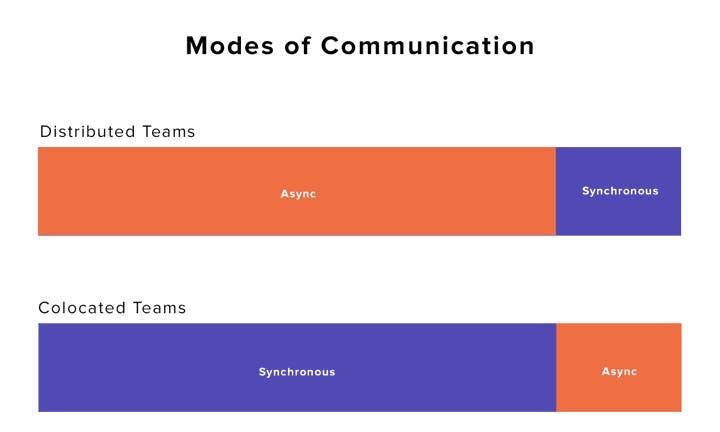Asynchronous vs Synchronous Communication: How Remote Work Changes the Way We Communicate

Asynchronous vs synchronous communication? Which should you use?
Before I dive into that answer, let me quickly share my background. Over the last several years, I've had the unique opportunity to have worked for distributed companies in a variety of roles (individual contributor, team leader, executive). In other words, I've seen what works and what doesn't.
Now that I'm building Friday, I've had many opportunities to sync up with other leaders at distributed companies to see if my theories hold any merit.
In this post, I want to share what I believe is the most important factor to distributed work. This is based on personal experience as well as discussions I've had with other leaders at growing, distributed companies.
Note: this post is a chapter from my upcoming book on distributed work. You can learn more here or read the previous chapter.
By the end of this post, you should:
- See how our work environment dictates what communication method we use.
- Learn about the key superpowers of asynchronous (delayed) vs. synchronous (real-time) communication
- Learn why scaling from one location to many locations is so tough for co-located companies
- Understand how to make work more flexible by matching the right communication tool for the job
Asynchronous vs Synchronous Communication
The first concept I'd like to briefly outline is the idea of real-time vs. delayed communication. Another term that is commonly tossed around is called synchronous and asynchronous communication, but I want to keep this post as simple as possible so I will limit using these definitions as much as I can.
Asynchronous communication (Delayed)
What is asynchronous communication? It is when two (or more) people can communicate without the requirement that they be “present” at the same exact moment in time.
Asynchronous communication is slower (not rapid fire back and forth), written, and tends to be more thoughtful because the sender has time to revise their communication before sending.
This format is ideal for sharing straightforward information where the potential to be misunderstood by someone else is low. If you are looking to transmit basic facts and information, this is a great way to do it. Another major benefit to this approach is that it automatically is saved for future reference as it persists.
Synchronous communication (Real-Time)
What is synchronous communication? It is real-time communication when two or more parties are talking or exchanging messages at the same time.
Think of quick back and forth discussion with coworkers, white-boarding sessions, etc. This tends to be rapid-fire communication and is most useful when people are trying to remove confusion or where the potential to be misunderstood is high. This form of communication contains body language, tone, and other "richness" to it. Typically, this communication does not persist either.
Here's an example :)
The office vs. remote work environment dictates what communication method we use
What many people do not realize is that our communication method is largely dictated by our environment. Please note, there are exceptions to the rules of thumb I present below, but this is where the gravitational pull will take you.
The office favors synchronous communication
At the office, one of the core value propositions is that when everyone is in one location, it makes it easier to have real-time (synchronous) conversations.
The design of the office itself tries to encourage people to adopt this way of working. The open-office floor plan (a generally bad idea) is designed to improve "collaboration", there are conference rooms where people can meet in real-time, and whiteboards make collaboration easy.
Additionally, when everyone shows up and leaves work at the same time, it reduces the cost of coordination. Put simply, real-time conversations are cheaper when you are at the office. Writing things down doesn't come as natural without effort and intentionality. For many, it feels like a duplication of efforts.
Remote work favors asynchronous communication out of necessity
Remote work in many ways is the inverse of the office environment. There's not much structure that forces people to naturally have real-time conversations or water-cooler discussion.
Teammates live in different timezones, so there's a cost of coordination to hold real-time conversations. Therefore, remote teams tend to prefer delayed communication out of necessity. Delayed conversations also enable distributed teams to have a more flexible work environment.
For example: I can wake up at 5am and work until 7am when my son wakes up. Then, I can write a post like this from a coffee shop. Later today, I will stop working around 4pm when I go pick my son up.
If we were to map out where the gravitational pull of communication styles takes us, it might look something like this:

I'm not good at making pictures, but the graphic above tries to illustrate that for remote teams, 80% of communication at work may be delayed (async), whereas the inverse applies for people who work in an office.
Each communication method has benefits, let's see what that looks like!
If you agree that there's a gravitational pull towards a particular type of communication for remote vs. co-located teams, one could extrapolate this idea a bit further and start to model out the benefits and downsides to each work environment.
These variables below are heavily based on a wonderful framework called communication grounding that I recommend you check out.
If you choose async communication...
If your team or company primarily communicates in a delayed way, one can expect the following to occur:
- Reviewability - there will be a persistent log of conversations that can be referred to over time as these conversations are mostly documented in writing. How organized this information might be is another story!
- Revisability - unlike in-person conversations, delayed communication allows the writer to revise their communication for clarity. This can lead to more thoughtful communication if done correctly. For example, the Amazon 6-page memo is a great example of the benefits to delayed communication as it enforces being thoughtful.
- Multi-threading - delayed conversations enable an individual to communicate in multiple "threads" at once. This can be a benefit, but also a downside.
If you choose synchronous communication...
If your team or company primarily communicates in a real-time way, you can expect the following to occur:
- Richer format - when people are together in the same location, there's a lot more data points (body language, facial reactions, tone) that one can use to establish common ground in a conversation. Media Richness Theory unpacks this idea in more detail.
- Faster feedback loop - unlike delayed communication (which is delayed), real-time conversations enable a faster feedback loop. This can be especially useful when working on thorny or ambiguous projects that don't have defined scope
- Observation & Cues- when you are in the office you can use all of your senses to observe the environment and the people in it. This can be useful as a new employee or when you're trying to learn a bit more about how someone likes to work.
When a good thing goes too far
Some people who work remotely think EVERYTHING should be done in an asynchronous format (including brainstorming sessions). Quite frankly, I think that's insane. Just like anything in life, if you go too far in one direction, you should expect some issues to arise.
Examples below:
- Downsides of remote work - you can feel lonely and disconnected. Collaboration can be more difficult with coworkers. This should be no surprise if the majority of communication happens in a delayed format.
- Downsides of the office - it can be difficult to focus. You may spend your entire day in pointless meetings. People easily forget conversations because the information doesn't persist. It's difficult to create a flexible work environment because everyone needs to be together, etc. This should be no surprise when most communication happens in real-time.
Scaling & Distance: When things start to break
Many co-located organizations that start to scale will open offices in new locations - it's a common playbook in the world of software. This is when things start to break.
Distance is the key variable here.
The processes that worked when everyone was in a single location no longer work. People feel disconnected from the HQ. Certain offices establish their own culture that may be very different from the rest of the company. Executives fly from location to location to try to hold things together and operationalize communication.
How does this breakdown happen?
I would argue that this is because the co-located company that relies on real-time communication starts to realize that it can no longer continue this way of communicating. The 80% of real-time conversations now need to be 60% real-time/40% delayed (or more).
It turns out that changing the way you communicate is tough, especially with a large group of people. Chaos ensures while this shift happens. This is behavior change at scale. This is messy.
The co-located companies that have been able to navigate and handle this transition more seamlessly are the ones that created a healthy balance between asynchronous and synchronous communication even as a co-located company. Stripe, Hubspot, etc.
In other words, it required less behavior change as they were already communicating this way.
Key takeaways
How we communicate at work should be based on picking the best communication tool for the job vs. letting our environment force us into a particular way of working.
The mode of communication with less friction may not be the right tool for the task at hand. This applies for any team, regardless of whether they are distributed or not.
There are times where remote teams need to get together in one room. There are times when a co-located company should ditch their weekly meeting because the information could be shared online instead.
This is not about favoring one way of communicating over another. It's about matching the communication to the task at hand. At Friday, we get excited about asynchronous communication in particular, especially for distributed teams.
From an employee perspective
If you are considering working remotely for a company, you should pay particular attention to what the breakdown is like between real-time conversations vs. delayed conversations. Is there a healthy balance? Does the remote company still try to replicate the office environment and hold meetings all day long? If so, that may be a warning sign for you.
In a future post, I will dive deeper into how you can match the communication channel to the task at hand. Feel free to subscribe to stay in the loop.
